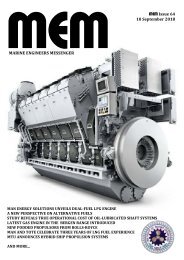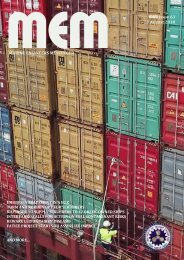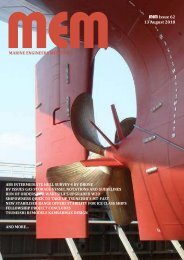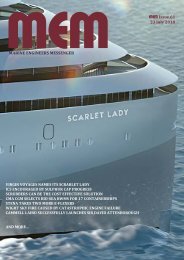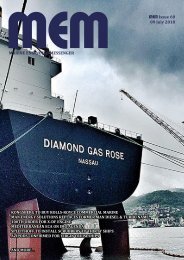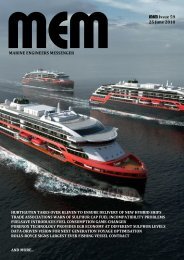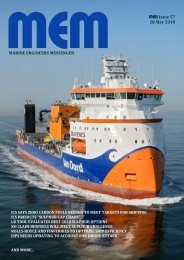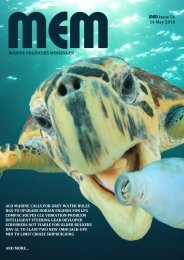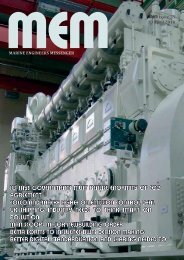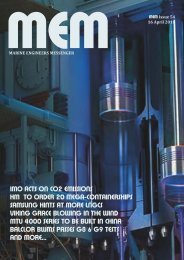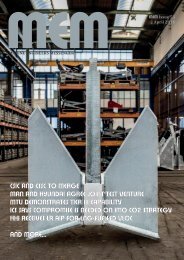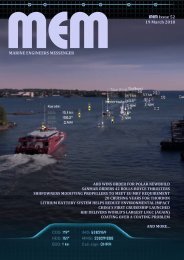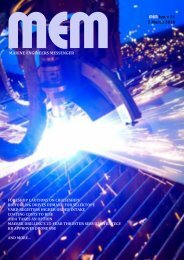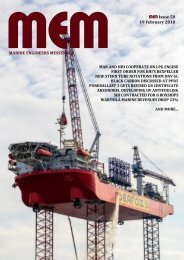MEM45
Marine Engineers Messenger, Volume 2, Issue 45
Marine Engineers Messenger, Volume 2, Issue 45
You also want an ePaper? Increase the reach of your titles
YUMPU automatically turns print PDFs into web optimized ePapers that Google loves.
MEM<br />
MEM<br />
MARINE ENGINEERS MESSENGER<br />
Issue 45<br />
4 December 2017<br />
ROLLS ROYCE BRINGS SPACE TECH DOWN TO EARTH<br />
TYPE APPROVAL FOR MAN D&T DUAL-FUEL ENGINE<br />
ABC HYBRID RECEIVES APPROVAL<br />
CLASS APPROVES 3D PRINTED PROPELLER<br />
RESEARCH PARTNERSHIP AIMS FOR ZERO EMISSION SHIPS<br />
LANGH TECH DELIVERS HYBRID SCRUBBERS<br />
LOW-MAINTENANCE CARGO HOLD PAINT DEVELOPED<br />
MHI REORGANISES ITS SHIPBUILDING BUSINESS
MEM<br />
MARINE ENGINEERS MESSENGER<br />
MEM Issue 45<br />
4 December 2017<br />
Telegraph<br />
Research carried out by the University of Arkansas’ professor of physics Paul Thibado has discovered a<br />
property of graphene that could be used as a source of clean, limitless energy.<br />
Thibado and his students studied the movements of graphene, which is composed of a single layer of carbon,<br />
finding strong evidence that the motion of two-dimensional materials could be used as a new energy source.<br />
Thibado has taken the first steps toward creating a device that can turn this movement into electricity, with the<br />
potential for many applications. He recently applied for a patent on this invention, called a Vibration Energy<br />
Harvester, or VEH.<br />
Thibado predicts that his generators could transform the environment, allowing any object to send, receive,<br />
process and store information, powered only by room temperature heat. He says this would have significant<br />
implications for the effort to connect physical objects to the digital world, the Internet of Things, since the selfcharging,<br />
microscopic power source could make everyday objects into smart devices and sensors.<br />
The discovery of graphene, a single sheet of carbon atoms, has created a wave of research in atomically thin<br />
two-dimensional materials.<br />
Inspired by graphene, researchers at the University of Arkansas are at the frontier of a new research<br />
direction to create atomically narrow one-dimensional wires, called "single atom chains." If successful, this<br />
work funded by a $60k Short-Term Innovative Research award from the Army Research Office could potentially<br />
revolutionise electronics.<br />
In the past, efforts to create nano-electronic components to surpass traditional silicon circuits have focused<br />
on one-dimensional nanotubes and nanowires. However, these earlier components either suffer performance<br />
degradation at the smallest sizes or possess random and difficult to control physical properties.<br />
This new research initiative aims to apply the previous findings to the creation of one-dimensional<br />
structures that can be fabricated using tellurium (Te). These materials not only have the capability of being<br />
exfoliated into ultra-thin nanowires, but also possess superior electrical, optical, mechanical, and chemical<br />
properties.<br />
This new structure is expected to push traditional electronics to the atomic endpoint of scaling, while<br />
opening up a new field of quantum circuits. In addition to electronics, these structures may also improve<br />
technological capabilities in sensing and communication. Given the technological promise of these structures,<br />
the researchers submitted a provisional application for a patent last spring and the university has already<br />
committed to a full patent application.<br />
The faculty hopes to build a larger atom-chain research initiative across several departments.<br />
Effective communication keeps your business<br />
afloat in a turbulent maritime environment<br />
Don’t let modesty close the door on a sales opportunity.<br />
Let Seaborne Communications open doors with an effective media<br />
and communications strategy that is proven to generate results.<br />
We make sure your stories are heard throughout the global shipping<br />
industry, from Asia to the Americas.<br />
W: www.seabornecomms.com<br />
E: enquiries@seabornecomms.com<br />
M: +44 (0)7984919345<br />
3
PRIME MOVERS<br />
TYPE APPROVAL FOR MAN D&T DUAL-FUEL ENGINE<br />
MAN Diesel & Turbo’s dual-fuel MAN L23/30DF engine successfully passed its Type Approval Test (TAT) last<br />
month, at Zhenjiang-based CSSC Marine Power (CMP).<br />
The five-cylinder test engine in China had an output of 125kW/cylinder at a nominal speed of 720/750rpm.<br />
Finn Fjeldhøj, Head of Small-Bore, Four-Stroke Engineering, MAN Diesel & Turbo, expressed the company’s<br />
high expectations for the engine and said: “The L23/30DF covers a power range of 625kW to 1,200kW, which<br />
makes it particularly attractive for such ocean-going vessels as bulkers of most sizes, general cargo ships,<br />
chemical tankers, and smaller LNG-carriers, as well as ships operating in ports and near the coast.<br />
Encouragingly, shipowners around the world have already shown significant interest in the engine and we are<br />
very optimistic about its future prospects.”<br />
● The TAT included tests of the engine’s:<br />
● SaCoSone alarm and safety system<br />
● dual-fuel safety concept, including a test of the pilot-fuel system<br />
● load-step performance;<br />
● components inspection.<br />
The MAN L23/30DF engine was also granted a certificate for compliance with IMO Tier III regulations in gas<br />
mode without any after-treatment equipment. In addition, the engine can provide up to 110% power output in<br />
both gas and fuel modes.<br />
ESL Shipping, a carrier of dry-bulk cargoes in the Baltic region, has already ordered the first six L23/30DF<br />
gensets for two 25,000-dwt cargo carrier newbuildings, currently under construction at CSC Jinling ship yard<br />
in China.<br />
The MAN L23/30DF’s fuel injection is a simplified system, especially developed for high reliability and cost<br />
efficiency as the main injector valve is also used for the injection of pilot oil. Accordingly, the MAN L23/30DF<br />
requires relatively low investment costs as fewer parts need to be replaced, as evidenced by its extreme Time<br />
Between Overhaul (TBO) of 36,000 hours.<br />
WÄRTSILÄ PACKAGE FOR CHINA-BUILT LNG FERRY<br />
Wärtsilä will supply the engines, the navigation system, and a broad scope of other products and systems for a<br />
new luxury and environmentally friendly ferry being built for the Finland based operator, Viking Line. The ship<br />
is being built at the Xiamen Shipbuilding Industry yard in China and there is an option for a second vessel.<br />
Six Wärtsilä 31DF dual-fuel engines running primarily on liquefied natural gas (LNG) will provide the<br />
propulsion and power for the vessel. This will be the first marine application for the dual-fuel version of the<br />
W31 engine.<br />
Wärtsilä will also supply its LNGPac fuel storage and supply system and Compact Silencer System (CSS),<br />
bow thrusters, the ballast water management system (BWMS), and Nacos Platinum integrated navigation<br />
system. The Nacos Platinum system integrates various functions into a single system, allowing the vessel to be<br />
navigated, controlled, and monitored from several onboard positions, thus providing unequalled flexibility and<br />
4
convenience. The Wärtsilä BWMS is designed to render the ballast water discharge harmless of invasive<br />
species. Legislation making this compulsory came into effect in September 2017.<br />
The recently launched Wärtsilä SmartPredict system is also included in the overall scope. This is designed to<br />
provide ships with greater safety and more efficient operations by displaying the vessel's predicted future<br />
position and heading. It evaluates the wind and sea forces affecting the vessel to provide advanced motion<br />
prediction and has a configurable prediction time display.<br />
"A new era in ferry operations was established in 2013 when Viking Line's Viking Grace with Wärtsilä dualfuel<br />
engines became the world's largest RoPax ferry to operate on LNG fuel. This latest Viking project<br />
represents another milestone as it will be the first vessel fitted with the highly efficient Wärtsilä 31DF engines.<br />
Both cases highlight the value our know-how and technology brings to our customers," said Roger Holm,<br />
President, Wärtsilä Marine Solutions.<br />
Jan Hanses, President and CEO, Viking Line, said: "The value of operating with Wärtsilä engines fuelled by<br />
LNG has been well established through our experience with Viking Grace. Furthermore, the LNGPac fuel system<br />
provides the necessary safety and non-stop operation required, so we had no hesitation in once again<br />
specifying Wärtsilä for this project.”<br />
Commencing in early 2021, the new vessel will operate across the Baltic Sea between Turku, Finland and<br />
Stockholm, Sweden. The ship is the first LNG fuelled ferry of this size and standard to be built in China.<br />
CUMMINS LAUNCHES NEW TIER IV ENGINE<br />
Cummins has introduced a US EPA-compliant Tier IV marine engine, with first installations expected in 2019.<br />
The new QSK38 engine is being paired with a Selective Catalytic Reduction (SCR) system designed and<br />
manufactured by Cummins Emission Solutions. Sensors located in the SCR can monitor performance, enabling<br />
precise injections of urea to neutralise the emissions. By monitoring the data and appropriately injecting urea,<br />
the system can ensure there is no waste, contributing cost savings for the customer, said the engine builder.<br />
Jim Schacht, Executive Director – Cummins Global Marine<br />
Business, said: “We know marine customers want the best<br />
value, quality and environmentally-friendly power solutions<br />
and that is what Cummins is firmly focused on bringing to<br />
them. We are thrilled to bring a proven technology to the<br />
marine market that embodies our mission and values. We<br />
have more than ten years of experience integrating SCR<br />
technology in both on-highway and off-highway<br />
equipment, which enable this clean and efficient<br />
technology to be brought to our customers seamlessly.<br />
“The QSK38 is a proven leader in the inland waterways, now<br />
with lower emissions and extended warranty coverage<br />
matched with the same world-class service and support. We<br />
are excited to continue the engines’ legacy,” Schacht<br />
continued.<br />
5
ABC HYBRID RECEIVES APPROVAL<br />
Medium-speed engine builder Anglo Belgian Corporation has received Bureau Veritas approval for its hybrid<br />
solution. The approval means ABC can offer its serial hybrid propulsion systems with various options<br />
including main engines, complete generator sets, power management systems, alternative power sources and<br />
even complete propulsion packages. ABC serves as a one-stop shop where customers can assemble a<br />
propulsion system for their specific requirements.<br />
The approval incorporates a new BV notation, ‘Electric-Hybrid’ - released by Bureau Veritas in July.<br />
ABC’s propulsion system options will be able to offer three modes described in the new Bureau Veritas<br />
notation:<br />
● PM (Power Management mode)<br />
● PB (Power Backup mode)<br />
● ZE (Zero Emission mode)<br />
Bureau Veritas’ Herman Spilker said: “This is the first time we have applied the ‘Electric-Hybrid’ notation<br />
and are very pleased to be able to support ABC in their development of an innovative propulsion solution. We<br />
anticipate that the performance, flexibility and sustainability of hybrid solutions will meet the needs of ABC’s<br />
customers.”<br />
Tim Berckmoes, CEO of Anglo Belgian Corporation, added: “This ABC Hybrid technology offers our clients<br />
an extra technologic advantage leading to zero emissions, higher performance and more flexibility. The Bureau<br />
Veritas Electric-Hybrid certificate confirms that the ABC hybrid system is solid and reliable with sufficient<br />
redundancies. Do not hesitate to contact our hybrid product specialists to help you in the right choice for your<br />
specific application.”<br />
The first target market for these hybrid systems are workboats such as tug boats, utility/support vessels,<br />
pusher boats, OSV’S, platform supply vessels and many more.<br />
GAS TURBINES<br />
LM500 TO POWER KOREAN PATROL CRAFT<br />
GE’s LM500 marine gas turbines are<br />
providing propulsive power to<br />
the Republic of Korea’s (ROK)<br />
first PKX-B patrol boat. The<br />
ROK Navy took delivery of<br />
its new surface combatant<br />
from Hanjin Heavy<br />
Industries in October<br />
The ROK Navy plans to<br />
acquire 16 PKX-B ships,<br />
each powered by two LM500<br />
gas turbines and two diesels<br />
engines in a combined diesel<br />
and gas turbine (CODAG)<br />
configuration. The PKX-B will complement the<br />
larger, PKX-A Gumdoksuri class patrol boats to<br />
provide maritime protection and defence in and<br />
along the ROK’s seaways.<br />
Brien Bolsinger, GE’s Vice President of Marine Operations said: “Thanks to our longstanding relationships<br />
in Korea, we were able to ensure an integrated PKX-B hull design featuring our compact LM500 marine gas<br />
turbines. It was beneficial to work directly with key component manufacturers in a complete system design<br />
analysis of the PKX-B to optimise all components and performance, from the gas turbine inlet to the water jet.”<br />
The PKX-B propulsion system includes improvements over its PKX-A predecessor. While both are powered<br />
by LM500 marine gas turbines, the starter is now electric and other changes were made to the packaging and<br />
integration to improve performance, reduce weight, simplify designs, save space and lower costs:<br />
GE maintains an integrated approach from build to delivery of the propulsion system to the ROK Navy,<br />
ensuring end-customer satisfaction; this is accomplished through Hanwha Techwin, a GE marine system<br />
partner. To date, Hanwha Techwin has provided 36 LM500 gas turbine propulsion modules for the PKX<br />
programme.<br />
As in the PKX-A programme, Hanwha Techwin will continue to locally manufacture selected LM500 parts as<br />
well as assemble, test and install the completed propulsion modules for each PKX-B ship. GE provides technical<br />
support and oversight of Hanwha Techwin’s LM500 master test cell operation, and supports the program<br />
during each phase of assembly, building, testing and installation. The GE-Hanwha partnership keeps GE<br />
engaged with key stakeholders while enabling timely customer and product support.<br />
6
TURBOCHARGING<br />
TURBOCHARGER TEST OFFERS HIGHER EFFICIENCY<br />
ABB Turbocharging says it has raised the industry<br />
benchmark for low-speed turbocharging efficiency to<br />
achieve an additional turbocharger efficiency increase of<br />
2% by performing the measurement on an actual engine<br />
on an engine testbed.<br />
As a performance yardstick for low-speed<br />
turbochargers, the industry applies the turbocharger<br />
efficiency benchmark given by MAN Diesel & Turbo, a<br />
leading global low-speed engine designer. ABB<br />
Turbocharging has now proven 2% higher efficiency<br />
compared to this industry standard.<br />
The ABB turbocharging efficiency benchmark test took<br />
place earlier this year on a Hyundai testbed in Korea.<br />
Three ABB latest generation A180-L turbochargers,<br />
produced by Hyundai under license, were fitted on an<br />
8G95ME-C9.5 engine and the turbocharging efficiency was<br />
measured accordingly. The measurement was performed<br />
with state-of-the-art wireless measuring equipment to<br />
ensure highest data accuracy.<br />
For marine operators the additional 2% efficiency<br />
increase achieved by the ABB A180-L turbochargers<br />
would mean annual fuel savings of up to US$35,000 per vessel, depending on fuel price and load profile. This<br />
efficiency increase was confirmed and verified by MAN Diesel & Turbo.<br />
Fuel and maintenance costs have the highest impact on lifecycle costs and therefore total cost of ownership<br />
(TCO). This efficiency increase in turbocharging and the resulting effect of lower fuel consumption and costs<br />
will have a direct positive impact on the overall TCO for application operators.<br />
Arie Smits, Senior General Manager, Product Group Low-Speed at ABB Turbocharging said: “The result of<br />
the measurement on an actual engine is a confirmation of our promise and commitment to continue to push for<br />
highest efficiencies and value for our customers. Promised, delivered and proven.”<br />
PROPELLERS<br />
CLASS APPROVES 3D PRINTED PROPELLER<br />
Following a rigorous testing process, verified by Bureau Veritas, the world’s first Class approved 3D printed<br />
ship’s propeller, the WAAMpeller, has been unveiled at Damen Shipyard Group’s headquarters in the<br />
Netherlands. The finished product is the result of a close collaboration between RAMLAB, Promarin, Autodesk,<br />
Bureau Veritas and Damen.<br />
The five-company<br />
partnership started pooling<br />
their collective resources<br />
and knowledge seven<br />
months ago. Promarin<br />
provided the design of the<br />
triple-blade propeller. The<br />
Port of Rotterdam’s<br />
RAMLAB (Rotterdam<br />
Additive Manufacturing<br />
LAB) carried out fabrication<br />
using Wire Arc Additive<br />
Manufacturing (WAAM)<br />
techniques, supported by<br />
Autodesk’s expertise in<br />
software, robotics and<br />
additive manufacturing.<br />
Damen provided<br />
research and development<br />
resources in addition to one<br />
of its Stan Tug 1606 vessels<br />
7
for operational testing purposes. Bureau Veritas’ role was to verify the entire development, production and<br />
testing process.<br />
The consortium reached its first milestone in August with the completion of the first WAAMpeller<br />
prototype. With valuable experience gained, production of the second version, with the aim of achieving class<br />
certification, started immediately.<br />
“Production of the second WAAMpeller was greatly improved because we had learned a lot from producing<br />
the prototype,” said Vincent Wegener, Managing Director RAMLAB. “This mainly concerned the<br />
hardware/software interaction because, when laying down 298 layers of Nickel Aluminium Bronze alloy, it is<br />
important to have a tight control on all process parameters.”<br />
With the second WAAMpeller complete, the project progressed to the testing stage, the first phase of which<br />
saw the WAAMpeller installed on a Damen Stan Tug 1606.<br />
“This particular vessel is of extra interest in that it is equipped with a Tier III compliant engine, making it<br />
future proof for the stricter environmental rules and regulations in harbours around the world,” commented<br />
Martin de Bruijn, Damen’s Managing Director, Workboats.<br />
Martijn Nieuwenhuijs, Chief Executive of Bureau Veritas Marine & Offshore Netherlands said: “Bureaus<br />
Veritas has witnessed every step of the making and testing of the WAAMpeller. Some challenges needed to be<br />
tackled along the way, but the final product is technically sound and ready for commercial application.”<br />
The testing programme included bollard pull and crash stop testing in addition to speed trials. The<br />
WAAMpeller was found to deliver the same behaviour as a conventional casted propeller in all of the tests,<br />
including crash stops.<br />
EMISSIONS<br />
RESEARCH PARTNERSHIP AIMS FOR ZERO EMISSION SHIPS<br />
By combining existing technologies in a new way, new ferries can be built that represent a quantum leap in<br />
environmental protection.<br />
That’s the premise behind a new research project involving four major players in the maritime sector: Rolls-<br />
Royce, Color Line, Norled and the Norwegian Coastal Administration. The project has now received a NOK 5.9<br />
million grant from the Research Council of Norway’s ENERGIX programme.<br />
The ‘Zero Emission Ferry’ project is intended to result in a new electrical system that not only provides<br />
more efficient power output and stable operations, but is cheaper to run, easier to integrate – and has a lower<br />
environmental impact. That is no mean feat aboard a ship, which typically has a hybrid system that is a<br />
thousand times larger than a hybrid passenger car.<br />
The four partners aim to achieve this by investigating new ways of combining systems for energy storage,<br />
8
energy management, onboard energy distribution and recharging. The work is already well underway, and the<br />
two ferry operators have specific goals with regard to the outcome.<br />
“Our aim is to gradually reduce the emissions produced by our fleet of car and high-speed passenger ferries,<br />
and become the first Norwegian operator with 100 per cent zero emissions. We are well underway with<br />
electrification on our short ferry routes, but are waiting for technology to become mature enough to be able to<br />
cover longer stretches. We are therefore delighted to be able to contribute our experience to this project,” said<br />
Lars Jacob Engelsen, Deputy CEO at Norled.<br />
Johann Martinussen, Color Line’s Superintendent Automation & Control, added: “This project is completely<br />
in line with our environmental strategy, in which the electrification of the fleet plays a key role. We want to<br />
exploit the energy on board more efficiently, reduce the operating time for our onboard machine park and<br />
ensure that we cover a larger proportion of our energy consumption from ‘green’ onshore power rather than<br />
fossil fuels.”<br />
The Norwegian Coastal Administration Shipping Company was one of the first Norwegian ship owners to<br />
use batteries on board. Their multifunctional vessel OV Bøkfjord is equipped with an environment-friendly<br />
hybrid system, a new vessel with an even larger battery pack is under construction, and the organisation has an<br />
option for a third such vessel.<br />
“We are proud to be part of this programme, and look forward to collaborating with the other partners. Only<br />
a few companies worldwide currently have much experience of shipboard electrification, but the four of us in<br />
this consortium are among the most experienced. The Norwegian Coastal Administration has an ambitious<br />
environmental strategy. Our newly constructed ships, our future ships and our participation in R&D<br />
programmes like this one are key contributions in this environmental strategy,” said Trond Røren, CEO of the<br />
Norwegian Coastal Administration Shipping Company.<br />
The objective is to develop a system that is commercially attractive for ship owners and as environmentfriendly<br />
as possible.<br />
“The aim is for the entire system or its component parts to be capable of use on both short-haul car ferries<br />
and big cruise ferries. Norway is far out in front with regard to green shipping, and we see an international<br />
export potential for these kinds of systems,” said Sigurd Øvrebø, General Manager Product Electric and Power<br />
at Rolls-Royce - Marine.<br />
LANGH TECH DELIVERS HYBRID SCRUBBERS<br />
Three container vessels on order for shipping companies Eimskip Island ehf and Royal Arctic Line A/S will be<br />
equipped with Langh Tech hybrid scrubber systems and water treatment systems for exhaust gas recirculation<br />
(EGR).<br />
The newbuildings are of a new energy-efficient design developed by Deltamarin, and will be built by the<br />
Guangzhou Wenchong Shipyard in China.<br />
The in-line scrubbers are multi-inlet installations, where the main engine and auxiliary engines are<br />
connected to the same scrubber tower. In addition, the MAN Diesel & Turbo two-stroke main engines for the<br />
newbuildings will be equipped with EGR systems designed to reduce NOx emissions to meet Tier III<br />
requirements.<br />
In the EGR process one third of the exhaust gas is washed to remove particles from the exhaust gas before it<br />
is recycled back into the engine. The process water is continuously cleaned during EGR operation, which is<br />
where Langh Tech’s water treatment technology is applied.<br />
After being cleaned, the purified process water is fed back to the process circulation or sent overboard.<br />
Similar water treatment is also used for the process water of the SOx scrubber system.<br />
Langh Tech is the first company to combine water treatment technology for both SOx scrubber process<br />
water and EGR process water. The technology is based on membrane filtration, through which the operational<br />
costs are kept low, and the amount of waste is compressed into only small amounts of dry sludge. Additionally,<br />
membrane filtration cleans the overboard discharge water far beyond MARPOL requirements.<br />
This is Langh Tech’s first contract for newbuildings from a Chinese shipyard.<br />
9
SCRUBBERS FOR SMALL CRUISE SHIP<br />
Ulstein Design and Solutions has awarded Wärtsilä with a<br />
contract to supply exhaust gas cleaning systems for a new<br />
104m long exploration cruise vessel building at the China<br />
Merchants Heavy Industry (Jiangsu) Co shipyard for<br />
Miami-based Sunstone Ships.<br />
The full Wärtsilä scope of supply comprises two 6-<br />
cylinder Wärtsilä 20 engines fitted with the Wärtsilä NOR<br />
(NOx Reducer) exhaust gas cleaning system, and two 8-<br />
cylinder Wärtsilä 20 engines. The Wärtsilä NOR is based<br />
on SCR technology. The system is compliant with various<br />
NOx emission reduction needs, such as the IMO Tier III<br />
rules.<br />
The Wärtsilä equipment will be delivered to the yard<br />
in January 2018, and the ship is expected to begin<br />
operations in September 2019.<br />
There are options for an additional nine vessels.<br />
FUELS & LUBRICANTS<br />
BUNKER SUPPLIERS MUST PREPARE FOR<br />
PROJECTED FOSSIL-FREE FUEL DEMAND<br />
Marine bunker suppliers should anticipate that there may<br />
no longer be significant demand for fossil fuels from<br />
shipping within as little as 25 years, if not sooner, and that<br />
the sector is now on an inevitable trajectory towards a<br />
future of zero CO2 emissions.<br />
This was the message that the International Chamber<br />
of Shipping (ICS) delivered to the Platts' Mediterranean<br />
marine bunker fuel conference in Athens last month.<br />
ICS Director of Policy, Simon Bennett, said:<br />
“'Governments need to recognise that many ships will<br />
remain dependent on fossil fuels probably at least until<br />
around 2050, just as some people in developed nations<br />
were still using horses in 1920. But the momentum<br />
created by the Paris Agreement on climate change means<br />
that the wholesale switch to alternative fuels and<br />
propulsion systems will be relentless and inevitable.<br />
'This will happen as soon as the technology and<br />
bunkering infrastructure permits, which ICS is confident it<br />
eventually will, whether using fuel cells or batteries<br />
powered by renewable energy, technologies such as<br />
hydrogen or some other solution we can't yet anticipate.”<br />
Commenting on the development by IMO Member<br />
States of a comprehensive strategy for addressing<br />
CO2 emissions from shipping, scheduled to be adopted in<br />
April 2018, Bennett said there was already broad<br />
consensus among governments that the goal was zero<br />
CO2 emissions and that IMO had already drawn up a list<br />
of possible short, medium and longer term candidate<br />
CO2 reduction measures for helping shipping to achieve<br />
this.<br />
ICS says that the most challenging area in the ongoing<br />
IMO negotiations is agreement on the levels of ambition<br />
for CO2 reduction, by the sector as a whole, before zero<br />
CO2 fuels become widely available.<br />
“Fuel is already by far shipping's greatest cost, and we<br />
already expect a truly massive increase in bunker costs as<br />
a result of the switch to low sulphur fuels required by the<br />
IMO global sulphur cap that comes into effect in January<br />
2020,” said Bennett.<br />
Type Approved<br />
to IMO MEPC<br />
227 (64)<br />
MARIPUR NF<br />
CLARIMAR MF<br />
ACO Marine's new MARIPUR NF and CLARIMAR MF advanced<br />
wastewater management systems are the merchant, naval and<br />
megayacht sectors most effective solutions for meeting<br />
stringent IMO MEPC 227(64)<br />
rules.<br />
Compact and economical<br />
with the lowest operating<br />
costs of any sewage<br />
treatment plant, CLARIMAR<br />
MF and MARIPUR NF are<br />
proven to reduce<br />
coliform bacteria, TSS,<br />
COD, nitrogen and<br />
phosphorous content to<br />
levels significantly below<br />
the mandated requirements.<br />
Mark Beavis - Managing Director<br />
Nádrazňi 72, CZ -15000 Praha 5,<br />
Czech Republic<br />
Tel: +420 724 011 775<br />
Email: mbeavis@acomarine.com<br />
Web: www.acomarine.com<br />
10
LNG<br />
WÄRTSILÄ PACKAGE FOR Q-LNG BARGE<br />
Wärtsilä has been selected to provide a broad scope of products and solutions for a new articulated tug barge<br />
(ATB). The vessel will be used to supply liquefied natural gas (LNG) fuel to cruise ships along the east coast of<br />
Florida, USA. This will be the first fuelling barge with a Wärtsilä solution operating in US waters, and is seen as<br />
being an important logistics link for the growth of LNG as a marine fuel in the USA.<br />
The 4000m3 capacity ATB is being built at the VT Halter Marine (VTHM) shipyard in Pascagoula, Mississippi<br />
on behalf of Quality Liquefied Natural Gas Transport LLC (Q-LNG). When delivered, the vessel will be on a longterm<br />
charter with Shell Oil Co.<br />
The ATB comprises a barge and a tug. The barge will be fitted with a Wärtsilä LNG cargo storage, handling,<br />
and control system. Wärtsilä will also supply the barge automation, power management, and ballast water<br />
management systems, as well the bow thruster. The tug will include Wärtsilä main propulsion steerable<br />
thrusters and shaft lines, the Wärtsilä NACOS Platinum dynamic positioning system, the tug automation, as well<br />
as all navigation and communication equipment.<br />
The order with Wärtsilä was booked in November 2017. Deliveries will continue throughout 2018 and<br />
2019, and the vessel is scheduled to commence operations in 2020.<br />
"Q-LNG is very pleased to again be partnering with Wärtsilä on yet another ground-breaking project.<br />
Wärtsilä's expertise in LNG systems, its solid reputation for top quality marine equipment, and its commitment<br />
to customer service fits in very well with Q-LNG's plan to advance the development of LNG as a marine fuel in<br />
North America," says Chad Verret, President of Q-LNG.<br />
Q-LNG is owned 70% by Shane Guidry and 30% by Harvey Gulf International Marine, a company that<br />
currently has six vessels under construction or in operation with LNG solutions supplied by Wärtsilä. The<br />
success of these installations, together with recommendations from Shell, were strong factors in the selection<br />
of Wärtsilä equipment for this project.<br />
ELECTRICAL<br />
ALEWIJNSE ELECTRICAL OUTFIT FOR DAMEN SIGMA LRPV<br />
Alewijnse Marine has been awarded a contract by Damen Schelde Naval Shipbuilding (DSNS) for the complete<br />
delivery, installation, commissioning and testing of the complete electrical fit-out for a new Damen Sigma<br />
10514 Long Range Patrol Vessel.<br />
As the project progresses, Alewijnse staff will be deployed both at the DSNS shipyard in Vlissingen and at<br />
the local foreign yard. Alewijnse is also currently working with DSNS on a two-vessel order for vessels of the<br />
same class for the Indonesian navy, the first of which was delivered in April this year.<br />
The agreement for the delivery of the complete electrical installation includes the integrated platform<br />
management system and the integrated bridge system. The work will be carried out by Alewijnse Marine Galati.<br />
The 105m, 2,365t warship will be built using a modular system. The bridge and engine room will be built in<br />
Vlissingen, the Netherlands, with the remaining four being built at the local foreign yard with support from<br />
Damen and its specialist contractors. On completion the bridge and engine room modules will be shipped to the<br />
local foreign yard for final assembly and delivery early 2020.<br />
11
MARINE COATINGS<br />
HEMPEL DEVELOPS LOW-MAINTENANCE PAINT FOR CARGO HOLDS<br />
Coatings manufacturer Hempel is launching its new cargo hold coating – Hempadur Ultra-Strength Fibre 47510,<br />
which the company says can result in a 40% reduction in cargo hold maintenance costs.<br />
This new coating, specifically developed to withstand the harsh conditions experienced by cargo holds, hatch<br />
covers and hatch coamings of bulk carriers, offers corrosion protection and long major repair intervals for<br />
owners and operators, as well as application simplicity for shipyards and applicators.<br />
It incorporates Hempel´s patented fibre technology to provide superior coating flexibility in critical cargo hold<br />
areas, whilst the self-toughening technology is activated by cargo heat, boosting the coating's mechanical,<br />
chemical and thermal resistance.<br />
Davide Ippolito, Group Project Manager, Marine, Hempel, said: "At Hempel we understand our customers'<br />
needs for high performing,<br />
ultra-fast curing cargo hold<br />
coatings that deliver a fast<br />
return to service, minimise<br />
maintenance costs, reduce<br />
vessel downtime and speed up<br />
holds cleaning operations and<br />
inspection. As the shipping<br />
industry continues to face<br />
challenging market conditions,<br />
the right investment in the<br />
optimum cargo hold coating,<br />
such as Hempadur Ultra-<br />
Strength Fibre 47510, will<br />
deliver an extraordinary<br />
reduction up to 40% in cargo<br />
hold maintenance costs for<br />
shipowners.<br />
"Hempadur Ultra-Strength<br />
Fibre 47510 builds on the<br />
technology behind our<br />
successful class-leading Hempadur Ultra-Strength 47500 – that has protected over 6.4 million square metres of<br />
steel since its launch in 2009 – elevating cargo hold protection to a higher level."<br />
According to the manufacturer, the heavy-duty coating exhibits “superior resistance” to abrasion, impact,<br />
cracking and chemical attack, combined with an easy to clean smooth surface. The self-priming, two-component,<br />
high build, pure epoxy coating can be applied at surface temperatures of -5°C/22°F. Its fast curing properties<br />
allow a rapid return to service – as short as just three days from coating to loading the first hard cargo – to<br />
minimise off-hire costs.<br />
CONDITION MONITORING<br />
DRONE SURVEYS RECOGNISED<br />
Robotics In Maintenance Strategies BV (RIMS) has received a certificate as a ‘Recognised External Specialist’<br />
from ABS and RINA, for the use of Remote Inspection Techniques (drones) during surveys of enclosed spaces.<br />
This follows the recent announcement that RIMS was the first company to receive an attestation from Bureau<br />
Veritas (BV) Marine & Offshore, as an approved service supplier.<br />
RIMS is a global provider of high tech, safe, autonomous and sustainable surveying and maintenance<br />
solutions. Its services aid the replacement of old, expensive, slower, high-risk and resource intensive<br />
maintenance activities, with new smarter drone and robotic technologies.<br />
The approval allows shipowners and managers to invite RIMS to attend during a Class survey, supporting the<br />
surveyors by showing the objects to be inspected live on screen, similar to that of a diving survey. Appointing<br />
RIMS to provide this service reduces the time to carry out scheduled survey work and also avoids unnecessary<br />
costs of access equipment such as scaffolding or cherry pickers. In turn this will lead to minimising risk and<br />
physical evidence, bringing benefits to owners, insurers and classification societies.<br />
David Knukkel, CEO of RIMS BV commented on the approval: “Being the first company in the world with the<br />
approval of Bureau Veritas, and now also receiving the approval from ABS and RINA, means that we managed to<br />
realise a real shift in the maritime industry with its acceptance of using new technology. These latest<br />
acknowledgements by these respected societies reinforces that we are delivering safe, sustainable, cost effective<br />
and quality approved services in the marine industry.”<br />
12
DIGITALISATION<br />
ROLLS ROYCE BRINGS SPACE TECHNOLOGY DOWN TO EARTH<br />
Rolls-Royce and the European Space Agency (ESA) have signed a ground-breaking cooperation agreement<br />
aimed at pursuing space activities in support of autonomous, remote controlled shipping and promoting<br />
innovation in European digital logistics.<br />
The Memorandum of Intent (MOI) forms part of ESA’s wider strategy. Jan Wörner, ESA’s Director General<br />
stated that, “ESA has a long history of working internationally with our partners across Europe. This agreement<br />
is another demonstration of the positive application of Space 4.0 and the desire for a United Space in Europe;<br />
maximising the integration of space into our economy and society.”<br />
Karno Tenovuo, Rolls-Royce, SVP Ship Intelligence, said: “The space industry has been operating assets<br />
remotely for many decades. The information, software and satellite-based technologies the sector has<br />
developed are wholly relevant to the work Rolls-Royce is doing to make the remote and autonomous ship a<br />
reality.”<br />
The collaboration with the Rolls-Royce aims to develop and validate new solutions for communication<br />
between vessel systems and shore based systems in addition to ship-to-ship communication. This will enable<br />
the operation of commercial remote and autonomous shipping, innovative cargo logistics, smart ports and<br />
future commercial marine vessels. The next generation of 5G communications will rely on seamless integration<br />
of telecom networks and services, and ESA’s Satellite for 5G Initiative (artes.esa.int/satellite-5g) exists to<br />
support the technical and supply chain progress required, and follow through to support development of the<br />
commercial services that this enables.<br />
“The current wireless carriers like satellite and associated infrastructure need to be developed to facilitate<br />
the development of remote & autonomous ships, as existing configurations were not designed for this purpose,”<br />
said Tenovuo. Furthermore, “Rolls-Royce and the ESA will look at developing satellite-based positioning for<br />
‘smart’ ships which will be based on its ‘earth observation platform’. This could create greater spatial and<br />
situational awareness for those operating the vessel remotely. It will also allow satellites to capture and share<br />
the data from a number of vessels simultaneously.”<br />
ESA already serves the maritime community with many satellite capabilities. SAT-AIS (Satellite Automatic<br />
Identification System) permits identification and global tracking of ships using cutting-edge space and ground<br />
technology, using low Earth orbiting satellites to act as information relays to serve the whole globe. This results<br />
in more efficient use of existing infrastructures, a tangible reduction in cost and a decrease in the<br />
environmental impact. The ESA developed Sentinel-1 satellite, part of the European Union’s Copernicus<br />
programme, is establishing a pivotal role in the sector. Last August, Sentinel-1 Earth observation data helped<br />
13
the US Coast Guard vessel Maple navigate through the legendary Northwest Passage, showcasing the enormous<br />
potential that satellite earth observation can have across the industry, particularly in ship-to-ship data<br />
transmission.<br />
Rolls-Royce and ESA also plan to cooperate in harnessing the power of big data. Data analytics, Machine<br />
Learning and Artificial Intelligence (AI) can improve operational efficiency, reliability and safety. Sensor data<br />
will inform augmented and virtual realities, or “digital twins”. A digital twin is an AI copy of a ship, including its<br />
systems, that synthesises the information available about the ship in a hologram. “It allows any aspect of an<br />
asset to be explored through a digital interface,” said Tenovuo, “creating a virtual test bench to assess the safety<br />
and performance of a vessel and its systems, both before its construction and through its lifecycle. By creating<br />
ships and ship technology in a virtual environment, new ideas and technology can be realised and tested in a<br />
shorter time frame.”<br />
Wörner summarised: “Space technologies provide tangible benefits for the citizens of Europe or of the<br />
member states of ESA. Partnerships, such as this one with Rolls-Royce, take solutions originally developed for<br />
the unique challenges of the space environment and bring them down to Earth. Space 4.0 and ESA’s Satellite for<br />
5G Initiative enable, support and foster developments, validations and trials of products and applications in<br />
diverse areas of the maritime industry, and this partnership between the European Space Agency and Rolls-<br />
Royce will enable satellites to serve ship intelligence, marine operations, navigation, cargo logistics, maritime<br />
safety, healthcare, passenger and crew communications.”<br />
WÄRTSILÄ ACTS SMART ON EFFICIENCY<br />
By applying smart technology to serve customers in a more sophisticated way, Wärtsilä aims to deliver greater<br />
efficiencies that lead to increased revenues and profitability for owners and operators. By orchestrating new<br />
developments through the use of high levels of connectivity and digitalisation, Wärtsilä intends to lead the<br />
industry's transformation towards a Smart Marine Ecosystem.<br />
"The world is moving towards a future that is more and more connected, and nowhere is this more apparent<br />
than in the shipping sector. The opportunities offered through smart technology will foster a new era of<br />
collaboration and knowledge sharing with customers, suppliers and partners," says Roger Holm, President,<br />
Wärtsilä Marine Solutions.<br />
Marine industry players are faced with major sources of inefficiency that impose a significant negative<br />
impact on business operations and profitability. These inefficiencies can be considered as 'waste'; the three<br />
most notable sources of such waste being overcapacity, inadequate port-to-port fuel efficiency, and time<br />
14
wasted waiting when entering ports and other high traffic areas. Eliminating this waste forms the basis of<br />
Wärtsilä's strategy towards ecosystem thinking.<br />
Wärtsilä sees four primary forces that will re-shape the industry. Shared capacity will improve fill rates and<br />
reduce unit costs; Big Data analytics will optimise both operations and energy management; Intelligent Vessels<br />
will enable automated and optimised processes; and Smart ports will result in smoother and faster port<br />
operations.<br />
"Servicing our customers means supporting them throughout the lifecycle of their installations. This means<br />
that we are looking at the smartest way of operating and maintaining assets, as well as optimising performance<br />
in order to have the safest, and most environmentally sound and efficient operating profiles. In the future, we<br />
shall be looking more holistically at customer business operations. Instead of optimising a single vessel, we may<br />
be optimising a fleet, or even the customer's business. In the long term, vessel-as-a-service becomes the<br />
ultimate means of providing asset and lifecycle management services," said Pierpaolo Barbone, President,<br />
Wärtsilä Services.<br />
Wärtsilä has already opened one Digital Acceleration Centre (DAC), located in Helsinki, to speed up<br />
innovation and to co-create with customers a range of new business models and solutions. These include the<br />
industry's most advanced intelligent vessel and other ground-breaking projects. A second DAC is scheduled to<br />
open in Singapore in December, and during 2018 two more will be opened in Central Europe and North<br />
America.<br />
AUTOMATION<br />
ABB ENHANCES SHIP AUTOMATION WITH NEW VISION<br />
ABB has unveiled a new situational<br />
awareness solution that it says will make<br />
vessel operations safer and more efficient.<br />
The solution can be used by officers<br />
anywhere onboard a ship and is said to<br />
mark the next step towards remotely<br />
controlled and ultimately autonomous<br />
ships.<br />
ABB Ability Marine Pilot Vision takes<br />
advantage of the latest advances in sensor<br />
technology and computer vision to offer<br />
multiple real-time visualisations of a vessel’s<br />
surroundings and new ways of perceiving its<br />
situation. A virtual model of the ship is<br />
superimposed on real surroundings, making it<br />
possible to see the operation from a third person’s<br />
perspective. The officer can switch between views instantaneously, making it<br />
easier to predict vessel motions and be alert to previously hidden obstacles or<br />
collision risks. The resulting improvement in situational awareness has<br />
significant benefits for safety and operational efficiency.<br />
“The launch of ABB Ability Marine Pilot Vision addresses an important step in the ongoing digitalisation of<br />
ship operations,” said Juha Koskela, Managing Director at ABB Marine & Ports. “This new solution indicates an<br />
important landmark in ABB’s digital strategy and offering for our customers. It also demonstrates the<br />
aspiration and technology leadership that ABB has to offer for the maritime industry.”<br />
“Computer vision has advanced significantly in recent years. With this new solution, ABB is leveraging that<br />
in order to present the ship and its environment in ways beyond ordinary perception. Crucially, we can do this<br />
in real-time in an intuitive fashion, which does not distract the crew from their work. In this sense, Ability<br />
Marine Pilot Vision extends the capabilities of the human senses,” said Mikko Lepisto, Senior Vice President of<br />
Digital Solutions at ABB Marine & Ports. “The solution can easily be installed on conventional vessels to<br />
improve situational awareness. What’s more, it enables new shoreside remote services, as well as totally new<br />
design options for new vessels as it provides unrestricted views of the surroundings from any location on<br />
board and even on shore."<br />
“ABB believes that the next generations of vessels will be electric, digital and connected. Our recent fuel cell<br />
solution launch and ABB Ability Marine Pilot Vision give substance to this,” Koskela added. “Ultimately, Vision<br />
delivers a completely new user experience in ship operations. It also brings remotely-operated or unmanned<br />
ships into clear view. Unmanned ships will be dependent on fault tolerant and reconfigurable critical systems.<br />
Fuel cells, energy storage and renewable energy solutions fit perfectly with these targets, without<br />
compromising energy efficiency.”<br />
15
MARITIME SECURITY<br />
TOTEM PLUS SYSTEMS TO INCLUDE NAVAL DOME CYBER PROTECTION<br />
Totem Plus is to offer its customers<br />
Naval Dome’s cyber defence solution as<br />
a supplement to its PC-based<br />
navigation and automation systems,<br />
following the signing of a Letter of<br />
Intent (LOI) with the cyber security<br />
specialist.<br />
The two Israel-based companies<br />
began cooperating in 2016 when the<br />
Naval Dome solution was used to<br />
protect the Totem Plus ECDIS, IMAC<br />
(Integrated Monitoring, Alarm &<br />
Control), VDR and BAM (Bridge Alert<br />
Management) installations aboard a<br />
5000TEU containership.<br />
Capt. Azriel Rahav, Chief Executive<br />
Officer, Totem Plus, said: “We are<br />
proud to be a pioneer of cutting edge<br />
maritime systems. Being able to offer<br />
the first maritime multi-layer cyber<br />
defence solution with our navigation and automation systems provides unrivalled protection to our customers.<br />
I don’t think any other ECDIS provider can offer this level of security without impacting performance.”<br />
“We opted to partner with Naval Dome because its cyber security solution is proven to offer affordable<br />
multi-layer protection designed specifically for maritime application. As a stand-alone device it doesn’t have to<br />
be integrated, so it can be used with any connected or unconnected system onboard ship. It is intelligence grade<br />
cyber protection that requires minimal human interaction.”<br />
Commenting on the vulnerability of navigation systems to cyberattack, Itai Sela, Chief Executive Officer,<br />
Naval Dome, said: “Although there is a concerted effort to ensure ships systems and data are properly<br />
protected, ECDIS is a weak link. If not protected, they can provide hackers with an easily penetrable ‘back door’<br />
to ship systems and data, due to the frequency with which charts are information is downloaded.<br />
“I am delighted that Totem Plus has agreed to offer its product portfolio with Naval Dome cyber protection. I<br />
cannot emphasise enough the commercial, environmental and safety impacts that an unprotected navigational<br />
system will have on operations should a cyberattack be successful. The solution we have developed will<br />
safeguard against this and protect Totem Plus customers from unauthorised access to critical systems.”<br />
Last year saw an unprecedented number of cyberattacks and indications from security analysts suggest<br />
2018 will be equally threatening, as more and more companies store data in the “cloud” and increase the<br />
number of internet-connected devices.<br />
“The threat is very real, and hackers are becoming increasingly more sophisticated in the methods they use<br />
to access data and manipulate system information,” said Sela.<br />
However, the results of a survey carried out last month by NSSLGlobal, an independent service provider of<br />
satellite communications and IT support, demonstrates a worrying lack of maritime cybersecurity training<br />
amongst ship crews.<br />
“While a good percentage of crews are aware that they have an important role to play in thwarting any cyber<br />
security breaches, the report highlighted that 84% of the [571] crew members surveyed claimed to have<br />
received limited or no cybersecurity training. This is a real concern. But our system takes away the human<br />
element,” he said.<br />
The cooperation agreement with Totem Plus follows a Memorandum of Understanding Naval Dome signed<br />
earlier this month with Lloyd’s Register to help establish standards and guidelines for maritime cyber defence.<br />
SHIPBUILDING<br />
MHI REORGANISES ITS SHIPBUILDING BUSINESS<br />
MHI is to establish two new wholly-owned companies as part of the reorganisation of its shipbuilding Business.<br />
Mitsubishi Shipbuilding Co., Ltd will focus on ships requiring intensive outfitting, while Mitsubishi Heavy<br />
Industries Marine Structure Co will build large ships and marine structures and develop ships for running on<br />
new fuels. Both new companies will commence operations from January 2018.<br />
As part of the new structure Mitsubishi Shipbuilding Co., Ltd. will consolidate the current capabilities of MHI's<br />
various shipbuilding bases (Shimonoseki, Nagasaki, etc.) to function as a business company exclusively<br />
dedicated to shipbuilding.<br />
16
Its corporate name was chosen to<br />
reflect MHI's long history in<br />
shipbuilding. Applying MHI's prowess<br />
in engineering, the new company will<br />
grow its business in ships that require<br />
intensive outfitting and in areas<br />
impacting the environment.<br />
Mitsubishi Heavy Industries Marine<br />
Structure Co, meanwhile, will carry on<br />
the construction of large ships making<br />
use of the Koyagi Plant of MHI's<br />
Nagasaki Shipyard & Machinery<br />
Works. The new company will also<br />
expand business in units<br />
accommodating new fuels and<br />
manufacture of marine steel<br />
structures.<br />
MHI will work closely with the two<br />
new companies, providing its total<br />
support toward the development of<br />
their business operations.<br />
CHINESE SHIPBUILDING<br />
SECTOR AGREES NEW GOALS<br />
Carbon emissions, safety and cyber<br />
security was at the top of the agenda<br />
at the annual Tripartite Shipbuilding<br />
Forum.<br />
At the end of last week’s two-day<br />
debate more than 100 delegates<br />
agreed that the industry needs to<br />
design ships differently and be more<br />
technologically innovative to reach<br />
world climate goals and counter cyber<br />
security risks.<br />
For over 16 years, Tripartite has<br />
provided an opportunity for<br />
representative associations of<br />
shipowners, classification societies<br />
and shipyards to discuss<br />
contemporary issues related to<br />
design, construction and operation of<br />
new and future ships.<br />
This year’s themes were<br />
decarbonisation of ships, safe design<br />
SAVE MILLIONS IN DRYDOCK<br />
COSTS AND OFF-HIRE TIME<br />
Hull of cruise ship after 5 years with Ecospeed coating with no replacement or major repair. This is the state<br />
of the hull when the ship came out of the water, without any cleaning or touch-up in drydock.<br />
When your hull coating never needs<br />
replacing or major repair, you can<br />
save a lot of money in drydock fees, offhire<br />
time, materials and labour.<br />
Most hull topcoats are designed to be<br />
replaced once or twice every five years.<br />
The full hull coating scheme has to be<br />
fully replaced every 10 - 15 years down<br />
to bare steel.<br />
Over that time period, the coating<br />
degrades and becomes rougher until it’s<br />
no longer worth trying to patch it up.<br />
And it costs you a fortune in fuel to<br />
compensate for the additional hull<br />
friction.<br />
Imagine a coating that’s guaranteed for<br />
10 years and is expected to last 25<br />
without replacement or major repair. A<br />
coating that gets smoother over time, not<br />
rougher!<br />
Imagine coming into drydock after 3 or 5<br />
years and finding that your hull coating<br />
only requires a few minor touch-ups and<br />
doesn’t even need to be washed off.<br />
Call us today for a quote to convert your hull to Ecospeed or start off right, with<br />
Ecospeed, on a new build.<br />
EU Office<br />
Phone: + 32 3 213 5318<br />
Fax: + 32 3 213 5321<br />
info@ecospeed.be<br />
www.<br />
US Office<br />
Phone: + 1 727 443 3900<br />
Fax: + 1 727 443 3990<br />
info@ecospeed.us<br />
.be<br />
and digitalisation. These issues are interlinked as they are all relevant to the creation of a more efficient<br />
seaborne transport system. At its most recent meeting in Nantong, China, hosted by China Classification Society,<br />
the forum reached several general conclusions on ship design and technology.<br />
The shipping industry urgently needs new ship designs, equipment, propulsion systems and alternative fuels<br />
to achieve the CO2 reduction goals established by the Paris Agreement on climate change, and the specific<br />
objectives to be established for international shipping by the UN IMO as part of its GHG reduction strategy.<br />
It was agreed that the shipping industry needs to use all available technology to a much greater extent, and<br />
increase technological innovation to reduce CO2 emissions to the ambitious degree required by the<br />
international community.<br />
The Tripartite forum has therefore established inter-Industry working groups with the aim of developing a<br />
better understanding of current R&D efforts for the new technologies needed by the shipping sector to realise<br />
its vision for zero CO2 emissions this century.<br />
The Tripartite participants hope that the general understandings reached at its meeting will send an<br />
important signal to all industry stakeholders about the vital role that everyone must play to deliver the<br />
continuous improvement of shipping's environmental performance now demanded by global society.<br />
17
The critical importance of the safety of seafarers and the ships which they operate were also part of the<br />
meeting's agenda. There are increasing concerns that new regulations governing ship designs aimed at further<br />
reducing CO2 emissions could potentially have adverse effects on the safe operation of ships.<br />
One example would be any legal requirements that led to a further reduction of engine power. The concern<br />
is that ships could get into problems during bad weather if the engine is insufficiently powered, putting both<br />
the crew and the environment at serious risk.<br />
When it comes to ship design and construction, it was generally agreed that the industry needs to adopt<br />
new methods and standards to create more resilient digital systems on board. A more layered approach to a<br />
ship’s digital system and greater segregation can increase safety, so that a single attack cannot readily spread to<br />
IT and other systems both on board the ship and ashore.<br />
The Tripartite forum agreed that in advance of its next meeting in 2018, the industry partners represented<br />
at Tripartite will work together to develop new design standards, which will help raise the resilience of ships’<br />
digital systems and make them more resistant to possible cyber-attacks.<br />
This year’s issues will be worked on over the coming year and form input to next year’s Tripartite meeting,<br />
which will be held in the Autumn of 2018 in the Republic of Korea.<br />
The organisations present at Tripartite also re-confirmed their ongoing collaboration towards Industry selfregulation<br />
as an important complement to the statutory regulations developed by IMO.<br />
NEW FORCE IN CHINESE SHIPBUILDING<br />
Danish and Chinese maritime industries have signed a collaboration agreement focusing on green technologies<br />
and maritime safety.<br />
Delegates from the Chinese organisation Shipbuilding Information Centre of China (SICC) together with<br />
Danish Maritime recently visited FORCE Technology in Lyngby, Denmark, where SICC agreed to assist in<br />
projects between FORCE Technology and Chinese shipyards.<br />
The Chinese shipbuilding industry is keen to focus on green technologies and yards are interested in<br />
partnering with Danish companies that possess green-tech know-how in ship design and fuel consumption.<br />
NEWBUILDS & DELIVERIES<br />
DAMEN HANDS OVER CREW SUPPLY VESSELS<br />
Damen Shipyards Group has<br />
delivered its first vessels to Marine<br />
Core & Charter LLC (MC2), a marine<br />
services company supporting the<br />
offshore energy sector in the<br />
Arabian Gulf.<br />
The first of the two FCS 4008<br />
vessels was delivered in late<br />
September, just two months after<br />
the initial contract signing. The<br />
second FCS 4008, AMIA, was handed<br />
over at a ceremony held at the<br />
Emirates Palace Marina in Abu<br />
Dhabi on the 23rd of November.<br />
Like her sister ship AMPI, AMIA<br />
has a top speed of 25kts, a range of<br />
1200nmiles and 140m2 of cargo<br />
deck aft. Both vessels are based on<br />
Damen’s ‘axe bow’ design.<br />
TEEKAY OFFSHORE ORDERS TWO MORE SHUTTLE TANKERS<br />
Teekay Offshore Partners has declared options with Samsung Heavy Industries for the construction of two,<br />
Suezmax-sized, DP2 shuttle tanker newbuildings. They will be based on the new Shuttle Spirit design which<br />
incorporates proven technologies to increase fuel efficiency and reduce emissions, including LNG propulsion<br />
technology.<br />
Upon delivery in 2020, these vessels will join Teekay Offshore’s Contract of Affreightment (CoA) fleet in the<br />
North Sea.<br />
18
FINCANTIERI TO BUILD MORE SEASIDES FOR MSC<br />
Fincantieri has confirmed it will build two Seaside EVO ships, in what marks a further evolution of the Seaside<br />
Class vessels built for MSC Cruises. The €1.8 billion contract was agreed during the Monfalcone shipyard’s<br />
delivery last week of MSC Cruises’ new flagship MSC Seaside.<br />
Giuseppe Bono, CEO of Fincantieri, said: “We are proud to have accomplished such an important project: a<br />
ship, for a new customer, the largest one ever built in Italy. This demonstrates not only our ability to satisfy the<br />
needs of the shipowners, but also the extraordinary operational level which Fincantieri has achieved. In fact, I<br />
would like to highlight that Seaview, the sister ship of Seaside, will be delivered in just 6 months in this same<br />
shipyard.”<br />
Bono added: “We believe we have built a highly innovative ship with MSC. She marks a further technological<br />
quality leap. Such a milestone has allowed us to gain the customer’s loyalty with another order for two new<br />
ships, which will [again] represent a real evolution.”<br />
MSC Cruises Executive Chairman Pierfrancesco Vago said: “As we are nearing the end of 2017, we can look<br />
back on a year when we enjoyed unprecedented capacity growth. With two of the more innovative new ships in<br />
the industry having come into service in the past six months and now with the addition of two Seaside EVO<br />
ships to our investment plan, we are now even better positioned to further extend our global footprint. We are<br />
expecting the delivery of at least one new ship each year through 2026, with six to have come into service<br />
between 2017 and 2020. ”<br />
Following the new agreement between MSC Cruises and Fincantieri, the initial slot reservation agreement to<br />
build a third Seaside Class ship to be delivered in 2021 has been replaced to instead build the first of two<br />
Seaside EVO ships. The second ship is set to come into service in 2023.<br />
COMPANY NEWS<br />
NEW VSAT ALLIANCE<br />
Backed by Apax Partners, Marlink has signed a definite agreement to acquire a majority stake in OmniAccess.<br />
The existing management team of OmniAccess will remain unchanged and continue to keep a significant<br />
shareholding in the company.<br />
The new combined group will be a leader in maritime VSAT services, generating close to US$500M revenues,<br />
employing about 1000 people and operating a global infrastructure, supporting an install base of more than<br />
4000 VSAT vessels.<br />
While leveraging the Marlink Group capabilities, OmniAccess will remain a stand-alone company,<br />
functioning as the competence centre for broadband connectivity solutions for high-end cruise-line customers.<br />
“We are very proud that OmniAccess is joining forces with Marlink,” said Erik Ceuppens, CEO of Marlink<br />
Group. “OmniAccess is a truly unique company with in-depth understanding, expertise and capabilities to serve<br />
19
the sophisticated superyacht segment better than anyone else. Together, we extend and strengthen the Group’s<br />
global leadership position in the maritime broadband communication and IT market, with a unique position in<br />
all maritime segments.”<br />
“We are absolutely delighted to join forces with Marlink,” said Bertrand Hartman, CEO and founder of<br />
OmniAccess. “Marlink is a very reputable and well-established player and I am convinced that the extended<br />
capabilities and scale of this great cooperation model is very beneficial to all our customers and allows us to<br />
serve them better than ever.”<br />
The transaction remains subject to customary regulatory approval and Closing is expected in the first half of<br />
2018.<br />
INMARSAT EXPANDS IN NORWAY<br />
Inmarsat has opened a new office, at the Norwegian Maritime Competence Centre (NMCC) based in Ålesund,<br />
Norway, to continue to drive the digitalisation of the shipping industry.<br />
The opening of the facility in the heart of Norway’s maritime community signals Inmarsat’s intention to<br />
intensify work with third party innovators and digital disrupters to exploit high-speed broadband via Fleet<br />
Xpress through its Certified Applications Provider (CAP) programme.<br />
The maritime hub at NMCC, which is part of the Norwegian University of Science and Technology campus is<br />
recognised for its technical excellence, and is home to the influential Blue Maritime Cluster, whose members<br />
are leading the drive in remote monitoring equipment on board vessels and the use of data analytics for realtime<br />
decision making.<br />
Inmarsat CEO, Rupert Pearce said: “Inmarsat Maritime is driving digital best practice across tens of<br />
thousands of ships. The future of the connected ship lies in networks such as Fleet Xpress, brought to market at<br />
scale. Fleet Xpress enables application-triggered bandwidth, which will be key to converting today’s smart and<br />
connected ship into tomorrow’s ‘smart fleet’.”<br />
Inmarsat recently signed a Letter of Intent to enable the Rolls-Royce Energy Management System (EMS) via<br />
Fleet Xpress. Rolls-Royce is also based at the Ålesund NMCC, where it oversees its remote monitoring, data<br />
analysis, and ship performance strategy. Using the always-on connectivity of Fleet Xpress, EMS data is logged in<br />
real time so that its management software can optimise operational efficiency via its built-in verifiable<br />
reporting capability.<br />
Ronald Spithout, President of Inmarsat Maritime, said: “Ålesund opens a new chapter for the CAP<br />
programme and Inmarsat’s strategy to work with third parties on content-rich applications to populate the<br />
digital maritime world enabled by Fleet Xpress.”<br />
“We welcome all partners, whether their motivation is to develop greater operational efficiency, improve<br />
crew welfare, IT and security, or regulatory compliance. In addition to creating new revenue streams for<br />
partners, application-triggered bandwidth allows users to choose to dedicate connectivity to specific efficiency<br />
measures or for the application to trigger bandwidth ‘dynamically’ and transparently.”<br />
Fleet Xpress combines Inmarsat’s Global Xpress high speed data network operating on Ka-band with the<br />
ultra-reliable FleetBroadband service on L-band. Inmarsat Maritime is seeking to increase the penetration of<br />
Fleet Xpress services in the superyacht, cruise ship and offshore rig markets, Spithout adds. “With 10,000<br />
vessels committed for installation, Fleet Xpress is already enabling the merchant maritime industry to join the<br />
connected world, and we are only at the start of digitalisation in the industry,” he said.<br />
MEM Marine Engineers Messenger<br />
Publisher: Seaborne Communications Ltd<br />
Contributions: Bill Thomson<br />
Email: mem@seabornecomms.com<br />
Web: www.seabornecomms.com<br />
The information published in MEM does not<br />
necessarily represent the views of Seaborne<br />
Communications Ltd. The publisher makes no<br />
representation or warranty as to the accuracy or<br />
correctness of the information or accepts<br />
responsibility for any loss, damage or other liability<br />
pertaining to the information published in this<br />
newsletter.<br />
©2017 Seaborne Communications Ltd<br />
20




